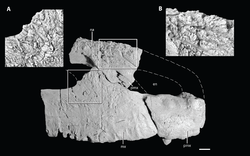Asperoris
|
Asperoris Temporal range: Middle Triassic, 245–242 Ma |
|
|---|---|
 |
|
| Front part of the skull | |
| Scientific classification | |
| Kingdom: | Animalia |
| Phylum: | Chordata |
| Class: | Reptilia |
| Clade: | Archosauriformes |
| Genus: |
†Asperoris Nesbitt et al., 2013 |
| Type species | |
|
†Asperoris mnyama Nesbitt et al., 2013 |
|
Asperoris is an extinct genus of archosauriform reptile known from the Middle Triassic Manda Beds of southwestern Tanzania. It is the first archosauriform known from the Manda Beds that is not an archosaur. However, its relationships with other non-archosaurian archosauriforms are uncertain. It was first named by Sterling J. Nesbitt, Richard J. Butler and David J. Gower in 2013 and the type species is Asperoris mnyama. Asperoris means "rough face" in Latin, referring to the distinctive rough texture of its skull bones.
Asperoris is known solely from the well-preserved but incomplete holotype skull NHMUK PV R36615, which includes the right premaxilla and maxilla bones of the upper jaw, the right nasal, prefrontal, frontal, postfrontal, and parietal bones of the top of the skull, and part of the right postorbital bone behind the eye socket, as well as three unidentified skull fragments. NHMUK PV R36615 was discovered by a joint 1963 expedition of the Natural History Museum and the University of London to eastern Zambia and western Tanzania (then northern Rhodesia and Tanganyika, respectively). Asperoris comes from Manda Beds of the Ruhuhu Basin in Songea Urban District of southwestern Tanzania, which dates back to the late Anisian stage of the Middle Triassic. Based on field notes, NHMUK PV R36615 was found on August 23 in a drainage of the Hita River between the Njalila and Hiasi rivers also known as locality U9/1 of the Lifua Member of Manda Beds, near the remains of dicynodonts. It was fully described in 2013 and assigned to a new genus and species, Asperoris mnyama, by Sterling J. Nesbitt, Richard J. Butler and David J. Gower in the journal PLoS One. The generic name is derived from asper, meaning "rough", and oris, meaning "face" in Latin in reference to its rough and uniquely sculptured skull. The specific name mnyama means "beast" in Swahili.
...
Wikipedia
